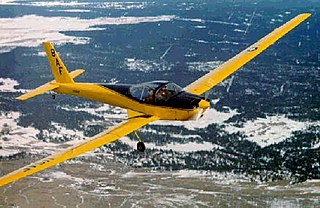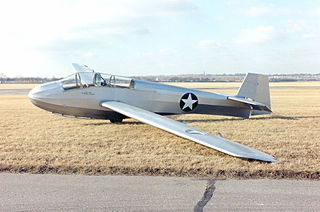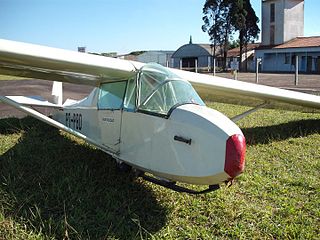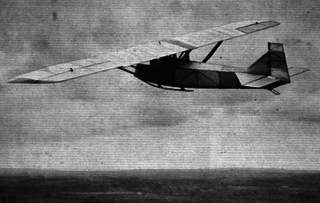Operators
 United States
United States
| TG-31 | |
|---|---|
| Role | Training glider |
| National origin | United States |
| Manufacturer | Aero Industries Technical Institute |
| Primary user | United States Army Air Force |
| Number built | 1 |
The Aero Industries TG-31 was a 1940s American military training glider, designed and built by students at the Aero Industries Technical Institute as the Aero Industries G-2 and impressed into military service as the Aero Industries TG-31 on 29 June 1942.
The Aero Industries TG-31 design was a high-wing sailplane design of wood-steel-fabric construction, with a single wheel aft of the nose skid. One G-2 sailplane (civil registration NC19965) was impressed into USAAF service on June 29, 1942 and allocated the designation TG-31 and the serial number 42-57171. [1]
Data from [2]
General characteristics
Performancedive or glide speed
Related lists

The L-13 Blaník is a two-seater trainer glider produced by Let Kunovice since 1956. It is the most numerous and widely used glider in the world. In United States Air Force Academy service, it is designated TG-10C and was used for basic flight training up to 2012.

The Aeronca L-3 group of observation and liaison aircraft were used by the United States Army Air Corps in World War II. The L-3 series were adapted from Aeronca's pre-war Tandem Trainer and Chief models.

The Schweizer SGS 2-33 is an American two-seat, high-wing, strut-braced, training glider that was built by Schweizer Aircraft of Elmira, New York.

The Schneider Grunau Baby was a single-seat sailplane first built in Germany in 1931, with some 6,000 examples constructed in some 20 countries. It was relatively easy to build from plans, it flew well, and the aircraft was strong enough to handle mild aerobatics and the occasional hard landing. When the Baby first appeared, it was accepted wisdom that the pilot should feel as much unimpeded airflow as possible, to better sense rising and falling currents of air and temperature changes etc.

The Frankfort Cinema was a sailplane manufactured in the United States in the 1930s and 1940s and which was used by the United States Army Air Corps as a training glider under the designation TG-1. It was a high-wing, strut-braced design with a fully enclosed cabin. Originally designed as a single-seater, a two-seat version designated the Cinema II was produced soon afterwards, and this design was put forward when the Army issued a requirement for training gliders. At the same time, the company was awarded production contracts for transport gliders, the CG-1 and CG-2.

The Schweizer SGM 2-37 is a two-place, side-by-side, fixed gear, low wing motor glider.

The Schweizer SGS 2-8 is an American two-seat, mid-wing, strut-braced, training glider built by Schweizer Aircraft of Elmira, New York.

The Schweizer SGS 2-12 is a United States two-seat, low-wing, training glider built by Schweizer Aircraft of Elmira, New York.

The Schweizer SGS 2-25 is a United States two-seat, mid-wing, two-place competition glider built by Schweizer Aircraft of Elmira, New York.

The Laister-Kauffmann TG-4 was a sailplane produced in the United States during the Second World War for training cargo glider pilots. It was a conventional sailplane design with a fuselage of steel tube construction and wooden wings and tail, covered all over with fabric. The pilot and instructor sat in tandem under a long canopy.

The Neiva B Monitor, also designated B-2, is a Brazilian tandem two-seat glider aircraft designed and manufactured by Indústria Aeronáutica Neiva between 1945 and 1955 for primary training and general flying.
The Briegleb BG-6 was a 1930s single-seat glider designed by William G. Briegleb to be both factory and homebuilt.

The Schultz ABC was a 1930s American glider designed by Arthur B. Schultz.

The Pratt-Read TG-32 was a 1940s American military training glider, designed and built by the Gould Aeronautical Division of the piano manufacturer Pratt, Read & Company of Deep River, Connecticut, for the United States Navy. The Pratt-Read glider was a monoplane glider having a fabric-covered steel tube fuselage and wooden wings and tail. The unique "polywog (tadpole)" shape was the suggestion of aerodynamicist Charles Townsend Ludington, former owner of the Ludington Line.

The Franklin PS-2 is an American, high-wing, strut-braced, single seat, glider that was designed by R. E. Franklin and produced by the Franklin Glider Corporation starting in 1930.

The Midwest MU-1 was an American single-seat, high-wing, strut-braced utility glider that was designed by Arthur B. Schultz in the 1930s.

The Hütter Hü 17, is a German high-wing, strut-braced, single-seat, utility training glider that was designed by brothers Ulrich Hütter and Wolfgang Hütter in the 1930s.

The Aeronca K series, Aeronca Chief, Aeronca Super Chief, Aeronca Tandem, Aeronca Scout, Aeronca Sea Scout, Aeronca Champion and Aeronca Defender were a family of American high-winged light touring aircraft, designed and built starting in the late 1930s by Aeronca Aircraft.

The 1926 German RRG Prüfling of 1926 was a secondary training glider designed for club use. Plans were sold and it was built in Germany and across the world.
The Briegleb BG-08 was a 1940s two-seat glider designed by William G. Briegleb.